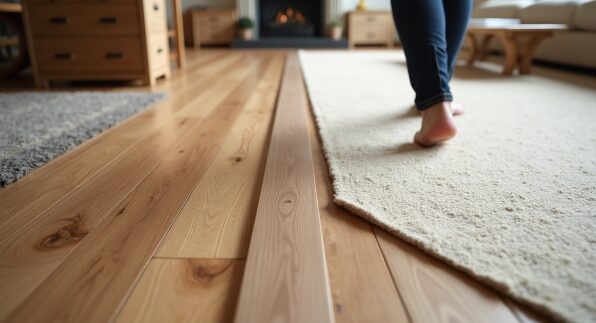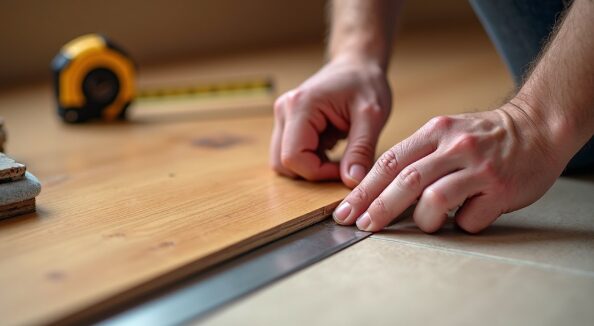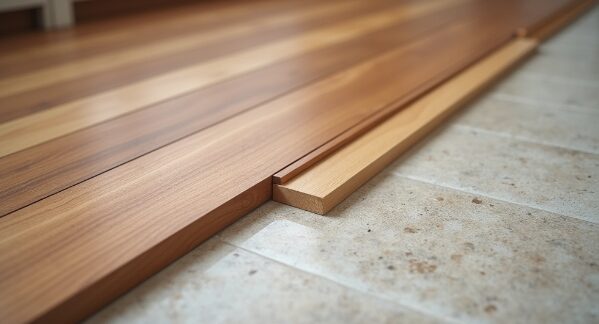When you think about flooring transitions between rooms, it’s all about seamlessly blending different floor types to enhance both the style and functionality of your space. These transitions not only create a polished and cohesive look but also ensure safety by eliminating tripping hazards.
For top-notch results, consider professional floor installation services in Vancouver, where experts can help your home feel effortlessly connected with flawless transitions. Engineered hardwood or luxury vinyl plank flooring can bring a touch of sophistication to any room, including your luxury master suite. With professional installation, you can ensure that the flooring not only looks stunning but also functions perfectly in high-traffic areas of your home. By choosing experienced professionals, you can trust that every detail will be attended to, from proper subfloor preparation to precise finishing touches.
Table of Contents
Key Takeaways
- Flooring transitions connect different floor types.
- They improve safety by reducing tripping hazards.
- Transition strips come in several styles.
- Plan carefully to avoid mistakes.
- Always leave room for expansion when working with floors.
For more information on various flooring types and their benefits, check out our comprehensive guide on flooring options for modern homes.
UnderstandingFlooring Transitions Between Rooms

Flooring transitions between rooms are key to creating a smooth and cohesive look in your home. Imagine walking from the soft comfort of a warm carpet to the sleek coolness of tiles without a bump—these transitions make moving around easier and safer.
To achieve this, you can use various materials, such as wood, vinyl, or metal, tailored to your style and needs. For professional results, consider expert floor installation services in Vancouver to ensure flawless transitions and a polished finish.
Why Are Flooring Transitions Important?
There are a few reasons why flooring transitions between rooms are important. First, they add style to your home—a well-chosen transition can make your floors shine and enhance the overall aesthetic. Second, they play a crucial role in safety. A sudden change in floor height can cause trips or falls, which you want to avoid, especially in your home. For expert assistance, consider professional floor installation services in Vancouver to ensure your transitions are both stylish and secure.
Types of Flooring Transitions
There are many types of transitions, each suited for different situations. Here are some common types:
T-Strip: This is the most common type. It is great when you have two similar floors that need to be met. The T-Strip sits in the middle, allowing both floors to move freely.
Reducer Strip: This type is used when one floor is higher than the other. It helps to reduce the height difference, making it safer to walk over.
Threshold Strip: This is used at doorways. It creates a neat finish where one room meets another.
End Cap: This is a good choice when you have a carpet meeting a hard floor, like tile. It helps to create a nice finish while keeping the edges safe.
Choosing Transition Strips
When choosing a transition strip, consider the materials of your floors. If you have hardwood floors, a wood transition strip works best. For tiles, you might want to use metal. You can also find vinyl strips that match your vinyl flooring.
Planning Your Transitions

Planning is vital for smooth transitions. Measure the area where the transition will go. This helps you choose the right strip. You should also check the heights of both floors. This way, you can select the proper type of transition strip.
Measure Carefully
Use a tape measure. Measure the width and length of the area where the strip will fit. It’s always best to double-check your measurements. A small mistake can lead to big issues later.
Consider the Height Difference
If there’s a height difference, you may need a reducer strip. This will help make the transition smooth without any gaps. It’s also a wise idea to leave a little space for expansion. Floors can change with temperature and humidity, and allowing for this change will help keep your floors in good shape.
Additional Considerations for Transitions
- Flooring Compatibility: Ensure that the transition strip materials complement each floor type.
- Color and Style Coordination: Match the color and style of the strip to enhance the aesthetic.
- Traffic Levels: Choose a more durable transition strip for high-traffic areas.
- Maintenance Needs: Consider the cleaning and maintenance required for each strip type.
Installing Transition Strips

Installing transition strips is a job you can do yourself. Here’s a step-by-step guide to help you out:
1. Gather Your Tools
Before you start, gather your tools. You will need:
- A tape measure
- A saw (if trimming is needed)
- Adhesive or nails (depending on the type of strip)
- A hammer or a nail gun
- A level
2. Cut the Strip
If your transition strip needs trimming, measure the length you need and cut it carefully. Always wear safety gear when using a saw.
3. Place the Strip
Once you have your strip cut, place it where it will go. Check that it fits well and looks nice. Use a level to make sure it is even.
4. Secure the Strip
Now, it’s time to secure the strip. You can use adhesive for a clean look. If you prefer, nails work too. Just be careful not to damage the surrounding floor.
5. Check the Fit
Once the strip is in place, check the fit again. Walk over it to ensure it feels smooth. It should not catch on shoes or feel uneven.
Common Mistakes to Avoid

Even small mistakes can create big problems. Here are some common issues to watch out for:
Skipping Measurements
Always measure twice. Skipping this step can lead to cuts that are too short or too long. It might mean a trip back to the store.
Not Accounting for Expansion
Floors can expand and contract. Not leaving room for this can create problems later. It’s best to follow the manufacturer’s guidance.
Choosing the Wrong Strip
Make sure to pick the right strip for your floors. Each type of material works differently. Picking a strip that doesn’t suit the floors can lead to problems.
Real-Life Examples from Vancouver, WA
In Vancouver, many homes have different flooring types. A popular choice is having hardwood in the living room and tiles in the kitchen. Transition strips help connect these areas.
A Kitchen and Living Room Transition
Imagine moving from a cozy hardwood floor in the living room to shiny tiles in the kitchen. Using a T-Strip makes this change smooth. It allows both floors to move without issues.
Outdoor Spaces
Many homes in Vancouver have outdoor spaces. If your patio has a different floor type from your living room, it’s essential to use a proper transition. This not only helps with looks but also keeps everyone safe.
Transition Types Comparison
| Transition Type | Best Use Case | Material Options | Aesthetic Appeal |
|---|---|---|---|
| T-Strip | Similar height floors | Wood, Vinyl, Metal | Seamless and subtle |
| Reducer Strip | Different height floors | Wood, Vinyl | Smooth elevation change |
| Threshold Strip | Doorway transitions | Wood, Metal | Neat and defined edge |
| End Cap | Carpet to hard flooring transition | Vinyl, Metal | Polished finish |
Conclusion
Flooring transitions between rooms are simple but essential. They help keep your home safe and stylish. You can handle transitions like a pro with the right planning and materials. Remember to measure carefully, choose the right strips, and follow the installation steps. Your home will look great and feel perfect!
Final Thoughts
Having a well-planned flooring transition between rooms makes a big difference in your home’s overall look and feel. It allows you to bring together different areas seamlessly, creating a cohesive and inviting space. Whether you choose T-strips, reducers, or thresholds, each option plays a crucial role in both style and functionality. Take your time, plan carefully, and enjoy the beautiful flow and harmony of your home.
For a deeper dive into installation techniques, explore our detailed guide on installing various flooring types.
Need Help?
If you feel overwhelmed, don’t worry. You can always ask a local expert for help. At Prestige Construction & Home Remodeling in Vancouver, WA, we are here to help. We can guide you through choosing and installing your flooring transitions. Contact us today for advice and a free estimate. We are always ready to assist you in making your home the best it can be!
Transition Installation Tips
| Tip | Description | Benefit |
|---|---|---|
| Measure Twice | Always double-check your measurements. | Prevents costly mistakes |
| Choose Right Materials | Match transition strip materials to flooring. | Ensures durability and style |
| Leave Expansion Space | Allow for floor movement due to temperature changes. | Protects the floor integrity |

